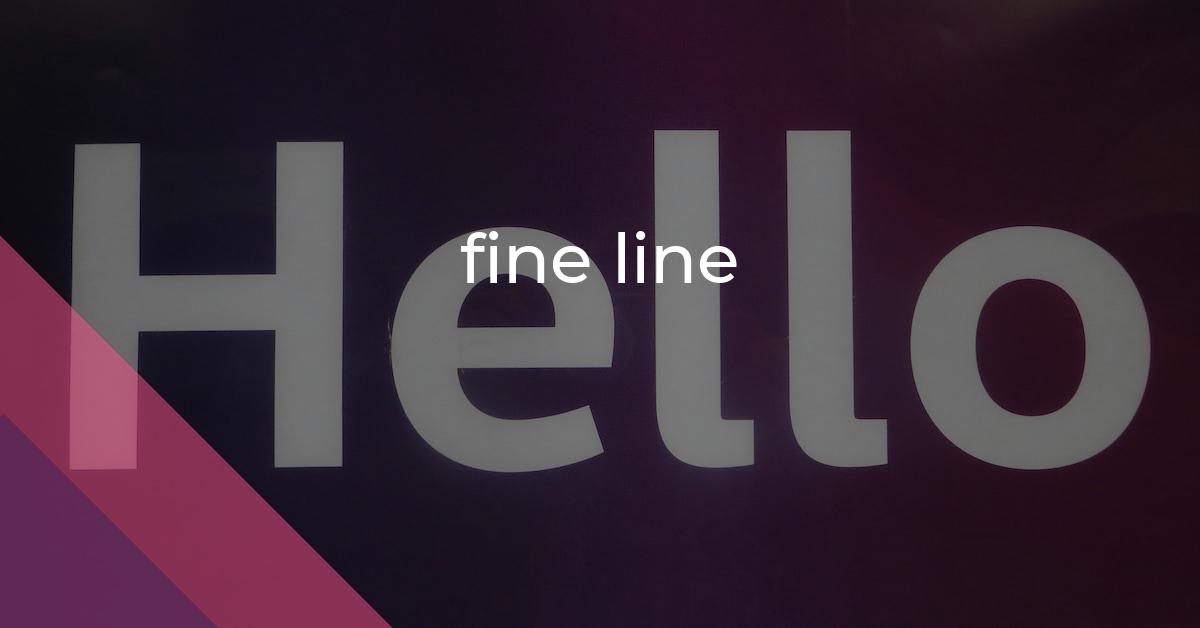fine line: Idiom Meaning and Origin
What does ‘fine line’ mean?
The idiom "fine line" refers to a very narrow distinction or difference between two things or situations.

Idiom Explorer
The idiom "lay on the line" means to take a risk or be open and honest about something, often exposing oneself to potential danger, criticism, or negative consequences.
The idiom "in line" means being in a position or sequence, typically waiting for something or following rules or instructions.
The idiom "in detail" means to explain or describe something thoroughly or with great attention to specific information or facts.
The idiom "in black and white" means something is written or documented clearly and explicitly, leaving no room for ambiguity or interpretation.
An idiom that means an extremely small or tight space, often used to convey a sense of constriction or being cramped.
The idiom "hard-and-fast" means having strict and inflexible rules or principles that must be followed without exception.
"Hair-splitting" means excessively focusing on minor details or distinctions that are not significant in the larger context.
The idiom "grey area" refers to a situation or issue that is unclear, vague, or not easily categorized as right or wrong.
The idiom "finer things" refers to high-quality or luxurious items or experiences, often associated with wealth or sophistication.
Deciphering Ambiguity
The idiom "fine line" is commonly used in the English language to describe a very narrow distinction or difference between two similar things or ideas. It implies that there is a subtle boundary between the two and that one must be careful to navigate it appropriately. This expression has its origins in the late 18th century, although its exact origin is uncertain.
"Fine line" is a phrase that has found its way into literature, media, and everyday language. It is often employed in discussions related to moral dilemmas, ethical choices, or complex decisions. The idiom has become a versatile tool for conveying the concept of a delicate balance or a situation where one must make a difficult decision.
In the legal context, the idiom "fine line" is frequently used to describe the delicate distinction between what is considered lawful and what is unlawful. It emphasizes the need to carefully interpret the law and acknowledge the subtle differences that can significantly change the legal implications of a situation. Lawyers and judges often find themselves navigating this fine line when making arguments or issuing rulings.
In the world of art, the idiom "fine line" is often used to convey the intricacies of creativity and aesthetics. It represents the boundary between different artistic styles, genres, or interpretations. Artists and critics frequently discuss the fine line that separates traditional and avant-garde, realistic and abstract, or commercial and independent art forms. It is this fine line that pushes the boundaries of artistic expression and challenges conventional norms.
Politicians and public figures also invoke the idiom "fine line" to describe the challenge of balancing opposing perspectives, interests, or actions. They are often faced with the task of finding a middle ground or compromise that respects both sides while navigating the complexities of political decision-making. Drawing a line that satisfies multiple stakeholders and ensures the best outcome for the greater good can be a delicate process.
Sports enthusiasts and athletes are familiar with the concept of the fine line between success and failure, victory and defeat. It highlights the importance of precision, skill, and meticulousness in achieving desirable outcomes. Athletes must constantly navigate this fine line in their pursuit of excellence, knowing that even the slightest misstep can make all the difference in their performance.
When we talk about "blurring the line", we mean to obscure or make less clear the fine distinction between two things. This could be done intentionally or unintentionally, and it often leads to confusion or ambiguity. Blurring the line can occur in various contexts, such as blurring the line between reality and fiction, or blurring the line between personal and professional life. It is important to recognize when the line is being blurred and take steps to clarify it.
Another related idiom is "drawing a line," which means to establish a clear boundary or limit. When we draw a line, we are setting a point beyond which we will not go. This can be done to assert our personal boundaries, establish rules or guidelines, or indicate a division between two things. Drawing a line helps us define our limits and maintain a sense of control and order.
Similar to "drawing a line," the idiom "drawing the line" also refers to setting a boundary or limit. However, "drawing the line" often implies a more decisive or assertive action. When we draw the line, we are making it clear that a particular action or behavior is unacceptable or will not be tolerated. This idiomatic expression is frequently used to assert one's standards or to express a limit that should not be crossed.
A "bright line" refers to a clearly defined and unambiguous boundary or rule. It is a demarcation that is easy to see and understand, leaving no room for interpretation or doubt. A bright line rule is often used in legal contexts to establish firm guidelines or standards. When there is a bright line, there is no fine line to navigate - the boundaries are clearly marked.
Lastly, we have the idiom "cut it fine," which means to do something narrowly or with very little time to spare. When we cut it fine, we are pushing the limits and taking a risk by leaving things to the last minute. This idiom is commonly used in situations where there is a deadline or a time constraint. Cutting it fine can be a high-pressure situation, requiring precision and efficiency to avoid any mishaps or delays.
The idiom "fine line" is a widely recognized expression in the English language that represents a narrow distinction or difference requiring careful navigation. It has been extensively used in literature, media, and everyday language to describe moral dilemmas, ethical choices, complex decisions, delicate balances, and subtle boundaries. Within specific contexts such as law, art, politics, and sports, the idiom takes on additional meanings related to interpreting the law, artistic expression, decision-making, and achieving success. The related idioms "blur the line," "draw a line," "draw the line," "bright line," and "cut it fine" further enrich the understanding and usage of the idiom "fine line."
Example usage
Examples of how the idiom "fine line" can be used in a sentence:
1. There's a fine line between being confident and being arrogant.
2. The comedian managed to walk a fine line between humor and offensiveness.
3. As an artist, she walks a fine line between inspiration and imitation.
More "Ambiguity" idioms



